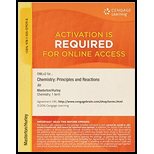
CHEMISTRY:PRIN.+REACTIONS-OWLV2 ACCESS
8th Edition
ISBN: 9781305079298
Author: Masterton
Publisher: Cengage Learning
expand_more
expand_more
format_list_bulleted
Question
Chapter 23, Problem 5QAP
Interpretation Introduction
Interpretation:
The two different monomers present in the given structure of the polymer needs to be identified.
Concept introduction:
A polymer is a long chain consists of large number of monomer units. In a polymer, the monomers are linked to each other in a continuous or repetitive manner. These monomer units are linked to each other either through the formation of peptide linkage, glycosidic linkage or by removal of any moiety such as a water molecule. Polyvinyl chloride, Bakelite and polystyrene are some of the examples of the
Expert Solution & Answer
Want to see the full answer?
Check out a sample textbook solution
Students have asked these similar questions
>
You are trying to decide if there is a single reagent you can add that will make the following synthesis possible without any other
major side products:
1. ☑
CI
2. H3O+
O
Draw the missing reagent X you think will make this synthesis work in the drawing area below.
If there is no reagent that will make your desired product in good yield or without complications, just check the box under the
drawing area and leave it blank.
Click and drag to start drawing a
structure.
Explanation
Check
?
DO
18
Ar
B
© 2025 McGraw Hill LLC. All Rights Reserved. Terms of Use | Privacy Center | Accessibility
Don't use ai to answer I will report you answer
Consider a solution of 0.00304 moles of 4-nitrobenzoic acid (pKa = 3.442) dissolved in 25 mL water and titrated with 0.0991 M NaOH. Calculate the pH at the equivalence point
Chapter 23 Solutions
CHEMISTRY:PRIN.+REACTIONS-OWLV2 ACCESS
Ch. 23 - Prob. 1QAPCh. 23 - Prob. 2QAPCh. 23 - Prob. 3QAPCh. 23 - Prob. 4QAPCh. 23 - Prob. 5QAPCh. 23 - Prob. 6QAPCh. 23 - Prob. 7QAPCh. 23 - Prob. 8QAPCh. 23 - Prob. 9QAPCh. 23 - Prob. 10QAP
Ch. 23 - Prob. 11QAPCh. 23 - Prob. 12QAPCh. 23 - Prob. 13QAPCh. 23 - Prob. 14QAPCh. 23 - Prob. 15QAPCh. 23 - Prob. 16QAPCh. 23 - Prob. 17QAPCh. 23 - Prob. 18QAPCh. 23 - Prob. 19QAPCh. 23 - Prob. 20QAPCh. 23 - How many chiral carbon atoms are there in ...Ch. 23 - How many chiral carbon atoms are there in sucrose?...Ch. 23 - Prob. 23QAPCh. 23 - Give the structural formulas of two different...Ch. 23 - (a) How many tripeptides can be made from glycine,...Ch. 23 - Prob. 26QAPCh. 23 - Prob. 27QAPCh. 23 - Prob. 28QAPCh. 23 - For alanine, Ka1=5.1105,Ka2=1.81010 . Calculate...Ch. 23 - Prob. 30QAPCh. 23 - On complete hydrolysis, a polypeptide gives two...Ch. 23 - Prob. 32QAPCh. 23 - Prob. 33QAPCh. 23 - Prob. 34QAPCh. 23 - Prob. 35QAPCh. 23 - Prob. 36QAPCh. 23 - Prob. 37QAPCh. 23 - Prob. 38QAPCh. 23 - Prob. 39QAPCh. 23 - Prob. 40QAPCh. 23 - Prob. 41QAPCh. 23 - Sketch the form in which leucine would exist in...Ch. 23 - How many tripeptides could one make from glycine,...Ch. 23 - A 1.00-mg sample of a pure protein yielded on...Ch. 23 - Describe what is meant by (a) the primary...Ch. 23 - Glycolysis is the process by which glucose is...Ch. 23 - Plants synthesize carbohydrates from CO2 and H2O...Ch. 23 - Prob. 48QAPCh. 23 - Prob. 49QAPCh. 23 - Prob. 50QAPCh. 23 - Prob. 51QAPCh. 23 - Aspartic acid acts as a triprotic acid with...
Knowledge Booster
Similar questions
- What is the name of the following compound? SiMe3arrow_forwardK Draw the starting structure that would lead to the major product shown under the provided conditions. Drawing 1. NaNH2 2. PhCH2Br 4 57°F Sunny Q Searcharrow_forward7 Draw the starting alkyl bromide that would produce this alkyne under these conditions. F Drawing 1. NaNH2, A 2. H3O+ £ 4 Temps to rise Tomorrow Q Search H2arrow_forward
arrow_back_ios
SEE MORE QUESTIONS
arrow_forward_ios
Recommended textbooks for you
 Chemistry: Principles and PracticeChemistryISBN:9780534420123Author:Daniel L. Reger, Scott R. Goode, David W. Ball, Edward MercerPublisher:Cengage Learning
Chemistry: Principles and PracticeChemistryISBN:9780534420123Author:Daniel L. Reger, Scott R. Goode, David W. Ball, Edward MercerPublisher:Cengage Learning Chemistry & Chemical ReactivityChemistryISBN:9781133949640Author:John C. Kotz, Paul M. Treichel, John Townsend, David TreichelPublisher:Cengage Learning
Chemistry & Chemical ReactivityChemistryISBN:9781133949640Author:John C. Kotz, Paul M. Treichel, John Townsend, David TreichelPublisher:Cengage Learning Chemistry: The Molecular ScienceChemistryISBN:9781285199047Author:John W. Moore, Conrad L. StanitskiPublisher:Cengage Learning
Chemistry: The Molecular ScienceChemistryISBN:9781285199047Author:John W. Moore, Conrad L. StanitskiPublisher:Cengage Learning Introductory Chemistry: An Active Learning Approa...ChemistryISBN:9781305079250Author:Mark S. Cracolice, Ed PetersPublisher:Cengage Learning
Introductory Chemistry: An Active Learning Approa...ChemistryISBN:9781305079250Author:Mark S. Cracolice, Ed PetersPublisher:Cengage Learning Principles of Modern ChemistryChemistryISBN:9781305079113Author:David W. Oxtoby, H. Pat Gillis, Laurie J. ButlerPublisher:Cengage Learning
Principles of Modern ChemistryChemistryISBN:9781305079113Author:David W. Oxtoby, H. Pat Gillis, Laurie J. ButlerPublisher:Cengage Learning World of Chemistry, 3rd editionChemistryISBN:9781133109655Author:Steven S. Zumdahl, Susan L. Zumdahl, Donald J. DeCostePublisher:Brooks / Cole / Cengage Learning
World of Chemistry, 3rd editionChemistryISBN:9781133109655Author:Steven S. Zumdahl, Susan L. Zumdahl, Donald J. DeCostePublisher:Brooks / Cole / Cengage Learning

Chemistry: Principles and Practice
Chemistry
ISBN:9780534420123
Author:Daniel L. Reger, Scott R. Goode, David W. Ball, Edward Mercer
Publisher:Cengage Learning

Chemistry & Chemical Reactivity
Chemistry
ISBN:9781133949640
Author:John C. Kotz, Paul M. Treichel, John Townsend, David Treichel
Publisher:Cengage Learning

Chemistry: The Molecular Science
Chemistry
ISBN:9781285199047
Author:John W. Moore, Conrad L. Stanitski
Publisher:Cengage Learning

Introductory Chemistry: An Active Learning Approa...
Chemistry
ISBN:9781305079250
Author:Mark S. Cracolice, Ed Peters
Publisher:Cengage Learning

Principles of Modern Chemistry
Chemistry
ISBN:9781305079113
Author:David W. Oxtoby, H. Pat Gillis, Laurie J. Butler
Publisher:Cengage Learning

World of Chemistry, 3rd edition
Chemistry
ISBN:9781133109655
Author:Steven S. Zumdahl, Susan L. Zumdahl, Donald J. DeCoste
Publisher:Brooks / Cole / Cengage Learning